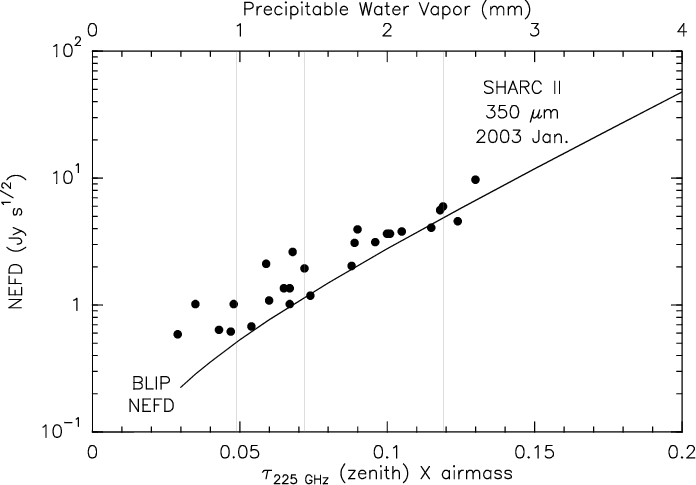SHARCII Instrument Status
Darren Dowell -- (626)395-6675 (office), 796-8806 (FAX)
Last modified Thursday, 07-Aug-2003 12:45 PDT
cdd@submm.caltech.edu
February 2003
Array
We now have capability to read the full 12x32 array. Approximately 330
of the detectors have good performance.
Filters
SHARC II has 3 filters in a manually-operated wheel: 350 microns, 450
microns, and 850 microns. We observe nearly background-limited performance
at 350 microns and expect the same at 450 microns. At 850 microns, we expect
an NEFD of about 1-2 Jy s1/2 -- 10-20x worse than SCUBA. We anticipate
very little observing at 850 microns.
Sensitivity

Preliminary 350 micron NEFD measurements (points) from the Jan. 2003
commissioning run compared to the theoretical expectation (line). We confirm
the performance of ~1 Jy s1/2 for tau(225 GHz) = 0.05.
We do not yet have NEFD measurements at 450 microns.
Field Rotation
SHARC II sits on an instrument rotator, which in principle can be used
to correct for parallactic angle rotation. The user should verify that the
actual rotator position (APA on antenna monitor) is close to the requested
rotator position (RPA), and also watch out for rotation-dependent pointing
offsets. Cable restrictions are fairly minor if things are set up well,
but should be monitored for large rotations.
Availability of Other Instruments with SHARC II Installed
SHARC II sits on the right port of the Cassegrain relay optics, the
same as SHARC I. With SHARC II on the telescope, the standard facility
heterodyne receivers in the sidecab can be used by positioning the swinging
tertiary mirror appropriately. SHARC II conflicts with the
850 GHz heterodyne receiver and probably most other instruments which mount
on the left port of the relay optics. At this time, it is not possible
to switch conveniently from SHARC II to Bolocam due to their different Cassegrain
structures.
Observing Modes
The primary observing mode of SHARC II is scanning without chopping.
We have developed two routines to collect data while performing linear and
curved controlled scans; they are called "SWEEP" and "BOX_SCAN" in the UIP.
SWEEP is most appropriate for maps comparable to the size of the detector
array, and BOX is better for larger maps. The stability timescale
of a SHARC II bolometer is approximately 10 seconds; to achieve full sensitivity,
one should scan from off source to on source to off source within this time.
We do not yet support chopped observations. Data have been acquired
and analyzed using a slow (1 Hz) chop, but this mode is not "released". Supporting
fast (>=3 Hz) chopping (which was used with SHARC I) is unlikely to become
a priority.
Analysis Software
Analysis software is under development at Caltech and Goddard. Operating
it away from the CSO may require Solaris or Linux and possibly JAVA or IDL.
More information will be made available when the software is near release.
Carrying out analysis in a timely fashion may require modern (>= 400
MHz) processor speeds.
Raw SHARC II data will be large in size (3 Gbytes on a good night), probably
too large for Internet transfer. We hope that users will be transporting
reduced data back to their institutions. Transporting raw data may require
purchasing storage media.
Go to SHARC II home page...
